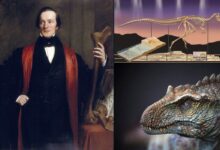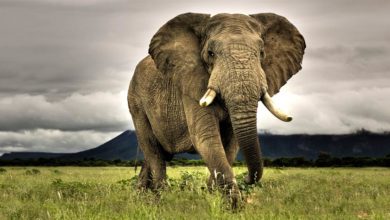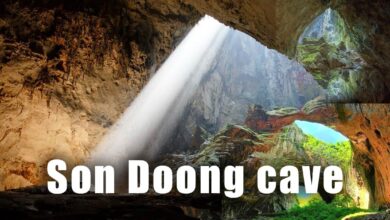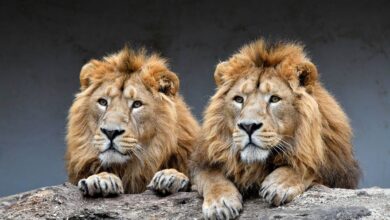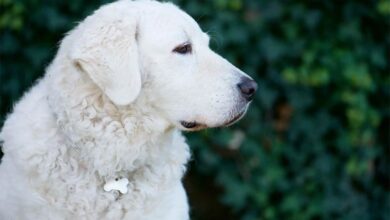Stegosaurus – “birdbrain”
Stegosaurus
Characteristic silhouette – a low, tilted head, a high raised tail equipped with sinister spikes and two rows of horn plates. This is one of the better-known dinosaurs (apart from the triceratops) – currently, museums contain the remains of over 80 individuals. Although today it seems to us to be huge, during the Jurassic period it performed next to giant sauropods and among them, it seemed to be… a dwarf – see the Largest dinosaurs.
Name
The name Stegosaurus comes from the Greek words στέγος- (stegos – “roof”) and σαῦρος (sauros – “lizard”). It means “covered lizard”.
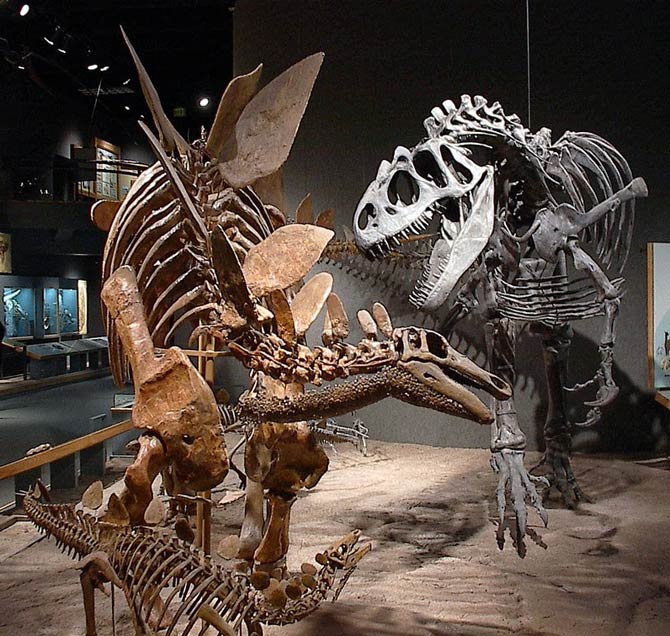
Characteristics
Stegosaurus was a large, heavily built and quadruped (four-legged running) herbivore with an unusual posture: the back was strongly arched, the front legs were short. The animal held its tail high in the air while its head was held close to the ground. Its plates and tail spines were the subjects of much speculation. While the latter was very likely used for defense, functions such as defense, temperature regulation or “courtship” have been suggested for the plates.
Each of the readers probably knows the characteristic silhouette of a stegosaurus. When you close your eyes, you can easily recall its most important features:
- Plates on the spine
- Spines on the tail
- A microscopic head against a large body
- A silhouette of a herbivorous dinosaur firmly seated on four legs.

Plates
The plates are the most distinctive feature of the stegosaurus. These plates did not have a bone skeleton, but were made of fossilized scales similar to those found in crocodiles and lizards today (osteoderms). They were also not directly connected to the dinosaur’s skeleton, but protruded from the skin.
The stegosaurus had 17 plates, the largest of them was located above the hips and reached a size of 60 x 60 cm (24 x 24 in).
The function of the plates
The function of the stegosaurus plates is still a matter of dispute today and there is no clear explanation – just like the Spinosaurus ‘sail’. Initially, it was assumed that they were supposed to be defensive, but they were too fragile and brittle to fulfill such a role.
A theory of thermoregulation was proposed – like the ears of modern African elephants. A theory was also considered in which the plates were to determine the attractiveness of the mating season (however, the fact is that they occur in both sexes). The dilemma was not finally resolved.
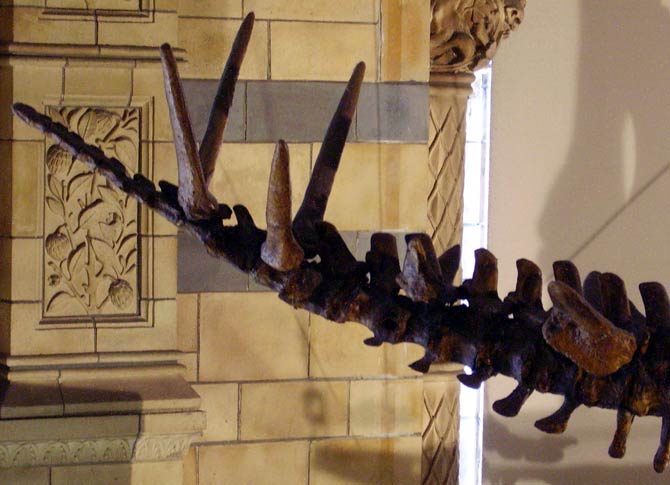
Spines on the tail
Currently, paleontologists assume that the spines served a defensive function (this is confirmed by the discovered Allosaurus skeleton, with a punctured caudal vertebra, which is ideally suited to the spike in the tail of a stegosaurus). Stegosaurus stenops had 4 spikes on its tail, each 60 to 90 cm (24 x 35 in) long. The findings so far confirm the thesis that there were no more than 4 spines and they were arranged horizontally, not vertically, as they are usually presented.
Quadruped
Today, the dominant theory is that stegosaurs were four-legged animals, although previously their bipedal character was assumed.

Paws
The Stegosaurus had front limbs much shorter than its powerful hind legs, which made it a slightly strange silhouette. The hind feet had three short toes, while the front feet had 5.
Tail and head – position
The tail according to modern research (as it is now accepted in most dinosaurs – see the change in the silhouette of a brontosaurus), the stegosaurs raised high above the ground. The head (due to the short forelimbs) was relatively close to the ground (not more than a meter (3 ft) above the ground).
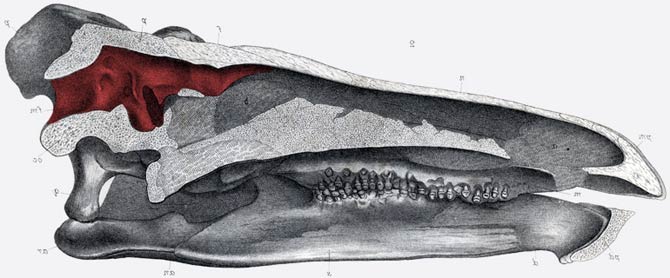
“Birdbrain”
Well, the Stegosaurus certainly couldn’t boast of outstanding intelligence. With a length of 9 meters and a weight of 4.5 tons, it had a brain weighing… 80 grams. It was therefore the smallest dinosaur brain ever discovered in relation to the proportions to its size.
“Second Brain”
Although a theory arose about a “second brain” located in the hip area, supposed to control the movements of the back part of the body, this hypothesis was quickly refuted.

Food
Stegosaurs were herbivorous dinosaurs. They didn’t have chewing jaws – they only made an up and down movement. They ate mosses, ferns, horsetails and cycads. Because they could not chew their food, they swallowed gastroliths (small stones) to break it down – much like modern birds and crocodiles.
Living in groups
The found remains indicate that the stegosaurs were herd animals. They lived in groups of individuals of different ages. Most likely, they also defended themselves together against attackers (such as Allosaurus or Ceratosaurus).
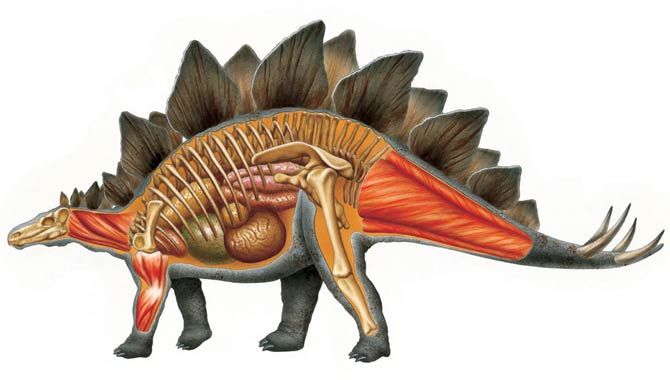
Species
We currently distinguish 3 certain species of stegosaurus and several nomen dubium (uncertain) species.
- Stegosaurus ungulatus (“hoofed roof lizard”) – 9 m (29.5 ft)
- Stegosaurus sulcatus (“furrowed roof lizard”)
- Stegosaurus stenops (“narrow-faced roof lizard”) – 7 m (23 ft) / best known / type species
- Doubtful species and junior synonyms
- Stegosaurus “affinis”
- Stegosaurus armatus (“armored roof lizard”)
- Stegosaurus duplex
- Diracodon laticeps
- Reassigned species:
- Stegosaurus marshi
- Stegosaurus priscus
- Stegosaurus longispinus
- Stegosaurus madagascariensis from Madagascar
Family
The stegosaurus family includes the following species:
- Dacentrurus – 8 m (26 ft)
- Kentrosaurus – 5 – 6 m (16.4 – 19.7 ft)
- Lexovisaurus – 5 – 6 m long (16.4 – 19.7 ft)
- Loricatosaurus – 6 m (19.7 ft)
- Stegosaurus – 7 – 9 m (23 – 29.5 ft)
- Tuojiangosaurus – 7 m (23 ft)
- Wuerhosaurus – 7 – 8 m (23 – 26 ft)
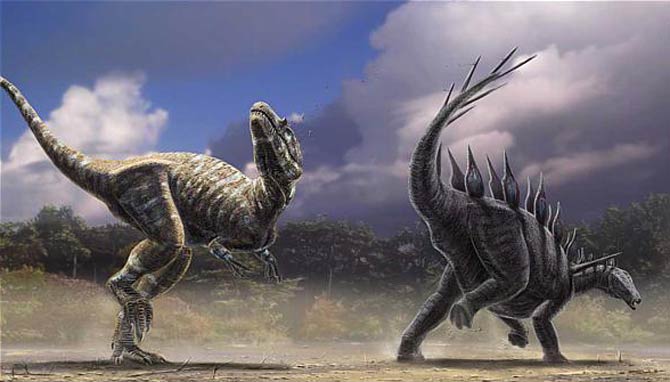
Detailed data / dimensions (size)
Stegosaurus
- Length: 7 – 9.3 m (23 – 30.5 ft) -> The longest Stegosaurus
- Height: 4 m (13 ft)
- Weight: 2.6 – 6 t / depending on the species -> The heaviest Stegosaurus
- Brain: 80 grams
- Speed: 5-7 km/h (3 – 4.3 mph)
Occurrence:
- Late Jurassic: 155-150 million years ago
- North America and Europe (Portugal)
Classification
- Kingdom: Animalia
- Phylum: Chordata
- Clade: Dinosauria
- Order: †Ornithischia
- Suborder: †Stegosauria
- Family: †Stegosauridae
- Subfamily: †Stegosaurinae
- Genus: †Stegosaurus
- Species:
- †Stegosaurus stenops
- †Stegosaurus ungulatus
- †Stegosaurus sulcatus

Recommended
- The longest dinosaurs. Sauropods Top 10
- The heaviest dinosaurs – Top 10
- The longest predatory dinosaurs. Theropods Top 10
- The heaviest predatory dinosaurs Top 10
- The longest Ornithischians (Ornithischia) TOP 10
- The heaviest Ornithischians Top 10
- The largest raptors (dromaeosaurs) Top 10
- The heaviest Dromaeosaurids / dromaeosaurs – Top 10
- The longest Ankylosaurus Top 10
- The heaviest Ankylosaurus Top 10
- The longest ceratopsians
- The heaviest cerapsians
- The longest and largest ornithopods
- The heaviest ornithopods Top 10
- The longest Stegosaurians (Stegosauria) TOP 10
- The heaviest Stegosaurians (Stegosauria) Top 10
- The smallest sauropods Top 10
- The smallest dinosaurs Top 10
- The largest pterosaurs Top 10
- Dinosaurs
- Dinosaurs database
- Predatory dinosaurs
- Animals & dinosaurs records
- The fastest animals – Top 100
- The fastest birds – Top 10





